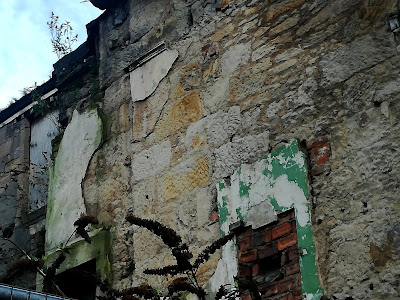Sites who educate: Collegelands
Leaving the ferns, I back away from the gutted building and turn my body around towards the mouth of High Street. In completing this movement, another whirl of matter clouds my vision and when I open my eyes it is slightly cooler and brighter and the road I was on is now a sandy track leading toward a towering cathedral. To my right is a squat building made of cream stone and dark wood with a steep roof, and I realise I have again returned to a time long before my own.
The building that ushered this realisation is called the Auld Pedagogy, and on the same plaque it reads ‘established in 1457’. I remember that this building existed because High Street was once the educational heart of the city, beckoning thought and knowledge to spring from those wynds and riggs I passed on my walk up the hill to Rottenrow. The Auld Pedagogy was a place for scholars to live, learn and rest. A medieval halls-of-residence, nestled a moment’s walk from the cathedral.
I begin my descent on High Street, realising that the steepness is once again sharper. I think that I must be back in the 15th or 16th century and that the early Renaissance period is gathering in pockets around the city. Along the High Street I notice men wearing crimson robes and laughing, speaking in a tongue I don’t understand. Is it true that the first students to the new-founded university were taught only to speak Latin?
With the cathedral as the main reason why the university was erected, it seems that the theology binded Glaswegians to their studies. Men were preferable students for scholarship at the Auld Pedagogy, with those seeking to become active members of the catholic church put forward as students. Women stayed home to ring linen and wash the ruddy cheeks of their children. Did the women living in and around High Street know that the maternal history of Rottenrow would carry forth into the twenty-first century? Did they ever imagine that an artist in 2008 would create a sculpture garden to celebrate the 550th anniversary of the university? Could they have ever pondered that?
I walk on the left hand side of High Street and I feel as though someone is looking at me. During this entire endeavour of time-skipping I have not stopped to wonder if I can be seen. I feel eyes on my back and I turn to see a group of men standing about fifty feet away. They are peering at me, sharing words with each other as I back away further down the hill. I turn around suddenly and there is a woman standing right in my place, but she doesn’t see me. She looks like me, and I wonder if she is my 15th century pre-self. I realise that nobody can see me and that I am a mere spectre from the future trying to understand the past. Is this psychogeography?
Feeling a little warped, I edge down a side-street. It is Duke Street and I am reminded of alighting here from the train during my own studies, back (or forwards?) in 2017, when I attended Glasgow School of Art. I can hear water and follow the sound towards a grouping of trees. Behind the trees there are steep banks edging a thin river flowing beneath. Women stand in the stream washing clothes. I think about this water as the real flow of knowledge, the actual stream of consciousness. The body of water is called Moledinar Burn and does not exist in the same way my time.
I sit with my feet in the stream and feel the water washing over my toes. I find it interesting that the educational heart of Glasgow was ripped out and re-placed in the late 19th century. It was designated that the West End was in fact a more desirable geographical setting for education and the university was dug out, uprooted and replanted on the other side of the city. A move of culture, wealth and hope of this scale would have had an undesirable impact on High Street, its sister streets, and the whole of the East End.




Comments
Post a Comment